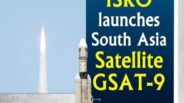India successfully launched ‘South Asia Satellite’ to diminish China’s role in space program.

Indian Space Research Organisation (Isro) on Friday put India’s space diplomacy into the orbit which India had desired three years ago, with the successful launch of the South Asia Satellite, marking a new era in regional communication and integration. Also called the Geostationary Communication Satellite-9 (GSAT-9), it will have a footprint that extends all over South Asia, allowing six neighbouring countries to use its benefits.
This is in line with India’s neighbourhood first policy, which leaders from all the member nations of the project acknowledged. The project cost India an estimated Rs 450 crore (including launch cost and other variables), while the satellite itself costs about Rs 235 crore. Isro said the launch went off exactly as planned, from the take-off at 4.57pm to the final separation about 17 minutes later. The control will now be taken over by the Master Control Facility in Hassan (Karnataka) and in the coming few weeks the GSAT-09 will reach the final orbit.

In its oval shaped Geosynchronous Transfer Orbit (GTO), the South Asia Satellite is now orbiting the Earth with a perigee (nearest point to Earth) of 169km and an apogee (farthest point to Earth) of 36,105 km with an orbital inclination of 20.65 degree with respect to the equator.
The 12 transponders in the Ku band that the satellite has put into space will provide a host of applications and services: TV, DTH, tele-education, tele-medicine, VSATs and disaster management support, besides giving India a secure hotline with the countries that can be used during disaster management and other emergencies.
This was GSLV’s 11th launch. Also it was the fourth consecutive success achieved by GSLV carrying indigenously developed Cryogenic Upper Stage. ISRO has termed it a textbook launch. Few seconds before the launch countdown reached zero, the four liquid propellant strap-on motors of GSLV-F09, each carrying 42 tonnes of liquid propellants, were ignited.
Exactly at count zero, after confirming the normal performance of all the four strap-on motors, the 139 ton solid propellant first stage core motor was ignited and GSLV lifted off at 4.57pm. The major phases of the flight occurred as scheduled. About 17 minutes after lift-off, South Asia Satellite was successfully placed in GTO.
This launch will definitely reduce Chain’a supremacy in South Asia space program and the mission which is set to benefit all SAARC countries minus Pakistan. Hope in coming days ISRO to continue with more feats and making various superpowers dependency on India’s space mission.

 Currency Convertor
Currency Convertor Post an article
Post an article eLive Today.
eLive Today.

 sending...
sending...




